|
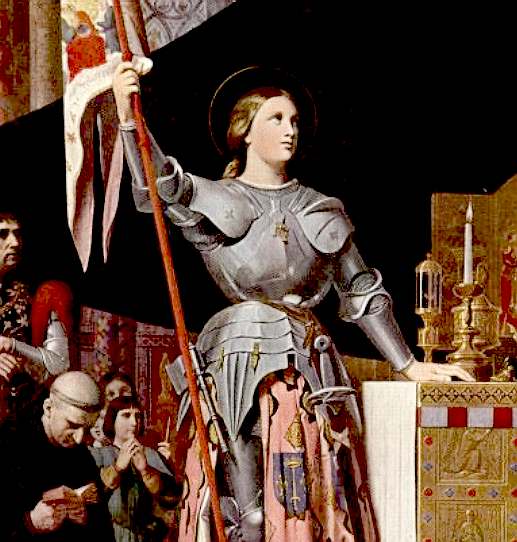
Joan
of Arc - the Maid of Orleans led troops into battle victorious, which infuriated
the English,
who then bought her from a back stabber, that she might be disposed of,
using the then prison system to ensure that she perished. Burning was a flavoured
form of punishment for those that challenged the political system of the
times.
The Trial of Joan of Arc, which was overseen by an English-backed church court at Rouen, Normandy in the first half of the year 1431 was one of the more famous trials in history, the subject of many books and movies. It culminated in the execution of the person known to history as Joan of Arc, the young French peasant girl who was the defendant in the case. The
trial verdict would later be reversed on appeal by the Inquisitor-General in 1456, thereby completely exonerating her. She is now considered a French national heroine and saint of the Roman Catholic Church.
Joan of Arc entered history during the spring of 1429. In obedience to what she said was the command of God, Joan inspired the Dauphin's armies in a series of stunning military victories which lifted the siege of Orleans and destroyed a large percentage of the remaining English forces at the battle of Patay, reversing the course of the Hundred Years' War. The Dauphin - Charles VII - was crowned a few months later at Reims.
However, a series of military setbacks eventually led to her capture. First, there was a reversal before the gates of Paris in September of that same year. Then in the Spring of 1430, she was captured in a minor action near Compiègne by the Burgundians, a faction led by the Duke of Burgundy who was allied with the English.
The Burgundians delivered her to the English in exchange for 10,000 livres. In December of that same year, she was transferred to Rouen, the military headquarters and administrative capital in France of King Henry VI of England, and placed on trial for heresy before a Church court headed by Bishop Pierre Cauchon, a supporter of the English.
DOCUMENTED PAST
The life of Joan of Arc is one of the best documented of her era. This is especially remarkable when one considers that she was not an aristocrat but rather a peasant girl. In one of history's genuine ironies, this fact is due partly to the trial record kept by the same individuals who attempted to eradicate her name from memory, and partly due also to the records of the later appeal of her case after the war when the trial was investigated and its verdict was overturned.
During the trial in 1431, a trio of notaries headed by chief notary Guillaume Manchon took notes in French which were then collated each day following the trial session. About four years later, these records were translated into Latin by Manchon and University of Paris master Thomas de Courcelles. Five copies were produced, three of which are still in existence.
The lengthy investigations and appellate trial during the 1450s produced additional information about the details and behind-the-scenes activity during the process, since the 115 witnesses questioned during these investigations included many of the clergymen who had served during the trial in 1431. They gave vivid memories of many incidents that are not recorded in the trial transcript, and described how the English government had manipulated the affair.
Jules Quicherat published the first unabridged version of the trial record in the first volume of his five-volume series Procès de condamnation et de réhabilitation de Jeanne d'Arc in
Paris in the 1840s. But it was not until 1932 that the first unabridged English translation became available when W.P. Barrett published his Trial of Joan of Arc in
New York.
PRISON
The procedures of an Inquisitorial trial called for a preliminary investigation into the life of the accused. This investigation consisted of the collection of any evidence about the character of the subject, including witness testimony. This could then be followed by an interrogation of the suspect, in which he or she was compelled to provide testimony which could then be used against them in a subsequent trial.
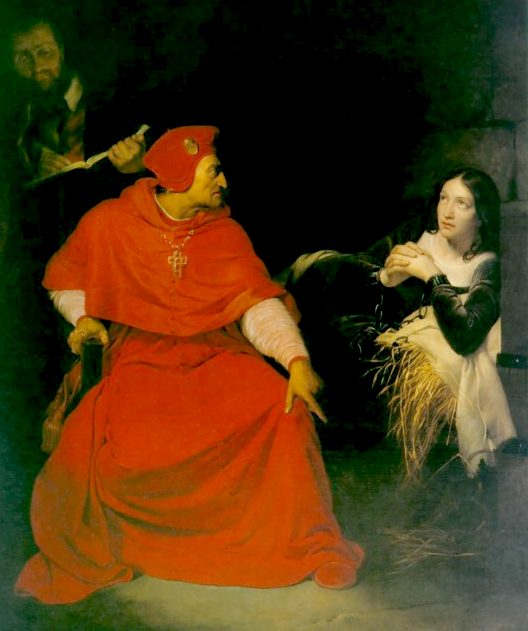
Joan
of Arc being interrogated by the Cardinal of Winchester in 1431. His
agenda was to kill our unfortunate hero, no matter what. Much like the
Spanish inquisitors and the Witch-finder General. Apart from the method of
disposal, not much has changed. Council's still target anyone
who exposes corruption in their regime.
PRELIMINARY INQUIRY
With the words "Here begin the proceedings in matters of faith against a deceased woman, Joan, commonly known as the Maid", the trial records announce the start, on January 9, 1431, of the judicial inquiry into the case of Joan of Arc (Jeanne d'Arc as her name appears at the head of said records).
The first order of business was a preliminary inquiry into Joan's character and habits. An examination as to Joan's virginity was conducted some time prior to January 13, overseen by the Duchess of Bedford (the wife of John, Duke of Bedford, and regent in France of the boy-king Henry VI of England). The Duchess announced that Joan had been found to be a virgin. At the same time, representatives of the judge were sent to Joan's home village of Domremy and vicinity to inquire further into Joan's life, her habits, and virtue, with several witnesses being interviewed.
The result of these inquiries was that nothing could be found against Joan to support any charges against her. The man who was commissioned to collect testimony, Nicolas Bailly, said that he "had found nothing concerning Joan that he would not have liked to find about his own sister". This angered Cauchon, who was hoping for something he could use against her. He accused Bailly of being "a traitor and a bad man" and refused to pay him his promised salary.
INTERROGATION
In a letter dated 20 February 1431 and sent to the assessors and others summoning them to appear the morning of the following day for the first public interrogation session of Joan, Pierre Cauchon cited the grant of jurisdiction within the city of Rouen by the chapter of the cathedral of Rouen for the purpose of conducting the trial against Joan. Without such a grant, he would have been unable to conduct the hearings as he was not in his native diocese. He also stated that Joan was "vehemently suspected of heresy" and that "rumors of her acts and sayings wounding our faith had notoriously spread". This was the basis for the diffamatio, a necessary ingredient in the bringing of charges against a suspect. He also alluded to the expected absence of the Vice-Inquisitor for Rouen, Jean Le Maistre, whose presence was required by canon law in order to validate the proceedings. Lemaitre's absence was later explained during the appellate trial by four eyewitnesses, who said Le Maistre had objections to the trial and refused to cooperate until the English threatened his life. The postwar appellate court would later declare these points to be violations of the Church's rules.
In response to the summons of Bishop Cauchon on this same date, priest and bailiff Jean Massieu reported that Joan had agreed to appear in court, but she requested that ecclesiastics of the French side be summoned equal in number to those of the English party (as required by the Church's rules), and she asked that she should be allowed to hear Mass. In response, promoter (prosecutor) Jean d'Estivet forbade Joan to attend the divine offices, citing "especially the impropriety of the garments to which she clung" according to the Trial transcript (Barrett translation). Her soldier's clothing would increasingly become an issue as the trial progressed and the tribunal failed to find other grounds for a conviction. Several eyewitnesses later said she had been wearing a soldier's outfit which had a tunic, hosen, and long boots that went up to the waist, all of which were tied together with cords, which she said she needed to protect herself from being raped by her guards (i.e., fastening the three items of clothing together made it difficult for the guards to pull her clothing off, but a woman's dress would leave her more vulnerable since it was open at the bottom).
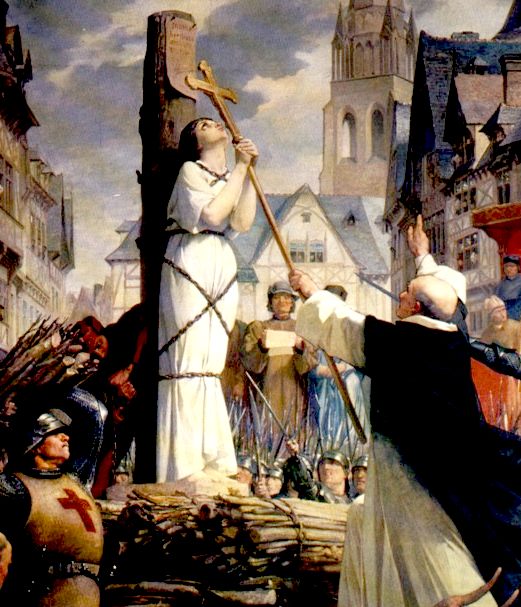
The Maid of Orleans
was burned alive because she defeated the English. Think on this. How is
it that a woman led an army? Men did not like women as leaders in those
days. Other famous women leaders include Cleopatra
and Boudicea.
FIRST SESSION: Wednesday, February 21, 1431
After being brought before the court, the proceedings were explained to Joan and an exhortation was delivered to her by Bishop Cauchon, following which she was required to take an oath concerning her testimony.
Question: Do you swear to speak the truth in answer to such questions as are put to you?
Joan: I do not know what you wish to examine me on. Perhaps you might ask such things that I would not tell.
Question: Will you swear to speak the truth upon those things which are asked you concerning the faith, which you know?
Joan: Concerning my father and my mother, and what I have done since I took the road to France, I will gladly swear to tell the truth. But concerning my revelations from God, these I have never told or revealed to anyone, save only to Charles, my King. And I will not reveal them to save my head.
The court would return to the matter of the oath in subsequent sessions.
She was then asked concerning matters such as her name, her birth, her parents and godparents, her baptism, and her religious upbringing. When she reported that her mother had taught her the standard Catholic prayers - the Pater Noster ("Our Father" or "Lord's Prayer"), Ave Maria ("Hail Mary"), and the Credo ("Apostles' Creed") - Cauchon asked her to recite the Pater Noster. She replied that she would do so only if she were allowed to be heard in Confession.
Finally, reminding her of her previous escape attempts, Joan was admonished against escaping, being told that if she were to do so, she would automatically be convicted of heresy. She rejected this, saying that she had given no oath regarding this matter to anyone and adding,
"It is true that I wished and still wish to escape, as is lawful for any captive or prisoner".
ORDINARY TRIAL
The ordinary, or regular, trial of Joan began on March 26, the day after Palm Sunday, with the drawing up of the 70 articles (later summarized in a 12 article indictment). If Joan refused to answer them, she would be said to have admitted them. On the following day, the articles were read aloud and Joan was questioned in French. The next two days, the extensive list of charges were then read to her in
French. The Ordinary Trial concluded on May 24 with the abjuration.
ABJURATION
On May 24, Joan was taken to a scaffold set up in the cemetery next to Saint-Ouen Church, and told that she would be burned immediately unless she signed a document renouncing her visions and agreeing to stop wearing soldiers' clothing. She had been wearing a soldiers' outfit consisting of a tunic, hosen, and long boots that went up to the waist, tied together with cords around the waist. The clergy who served on the tribunal later said Joan had kept this clothing tied tightly together during her months in prison because she said she needed such an outfit to protect herself from possible
rape: "[when the judge told her] that it wasn't proper for a woman to wear a man's tunic [and] hosen firmly tied together with many cords, she said she didn't dare give up the hosen, nor to keep them but firmly tied, because the Bishop and Earl well knew, as they themselves said, that her guards had attempted to rape her a number of times".
One of the court scribes, Guillaume Manchon, later recalled: "And she was then dressed in male clothing, and was complaining that she could not give it up, fearing lest in the night her guards would inflict some act of [sexual] outrage upon her; and she had complained once or twice to the Bishop of Beauvais, the Vice-Inquisitor, and Master Nicholas Loiseleur that one of the aforesaid guards had tried to rape her." The trial record omits much information on this issue, but does contain quotes from her protesting that she was not doing anything wrong.
But faced with immediate execution on May 24, she agreed to give up this clothing and sign the abjuration document.
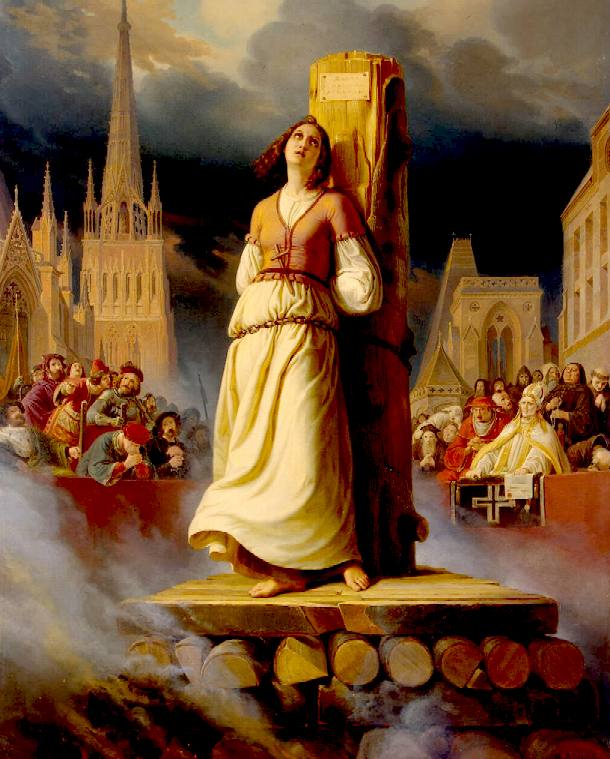
POLITICAL
MURDER - With the Church as co-conspirators to the crime. The way to rid
themselves of the troublemaker and discourage others, was to burn her as
an example of what happens to those who dare the change the system.
EXECUTION
On May 28, Joan recanted her previous abjuration, donned men's apparel once more, and was accused of relapsing into heresy. The chief trial notary later said: "she was asked why she had readopted this male clothing, to which she replied that she had done it for the protection of her
virginity, for she was not secure while wearing female clothing with her guards, who had tried to rape her, which she had complained about many times to the Bishop and Earl; and [she said] that the judges had promised her that she would be placed in the custody of, and in the prisons of, the Church, and that she would have a woman with her [i.e., a nun, following Inquisitorial procedure]; additionally saying that if it would please the lord judges to place her in a safe location in which she would not be afraid, then she was prepared to readopt female clothing".
The trial bailiff, Jean Massieu, remembered that in the end the English guards gave her no other choice but to put the male clothing back on: "When she had to get out of bed... she had requested of these Englishmen, her guards: 'Unchain me, so I can get up'. And then one of these Englishmen took away the female clothing which she had, and they emptied the sack in which the male clothing was, and tossed this clothing upon her while telling her, 'Get up'; and they put away the female clothing in the aforementioned sack. And, as she said, she put on the male clothing they had given her, [after] saying,
'Sirs, you know this is forbidden me: without fail, I will not accept it.' But nevertheless they wouldn't give her anything else, so that she continued in this argument with them until the hour of noon; and finally, she was compelled by the necessity of the body to leave the room and hence to wear this clothing; and after she returned, they still wouldn't give her anything else [to wear] regardless of any appeal or request she made of them."
She was declared "relapsed", giving the court nominal justification to have her executed. "Only those who had relapsed – that is, those who having once adjured their errors returned to them – could be condemned to death by a tribunal of the Inquisition and delivered for death."
On May 30, 1431, Joan of Arc was burned at the stake at the Old Marketplace in Rouen.


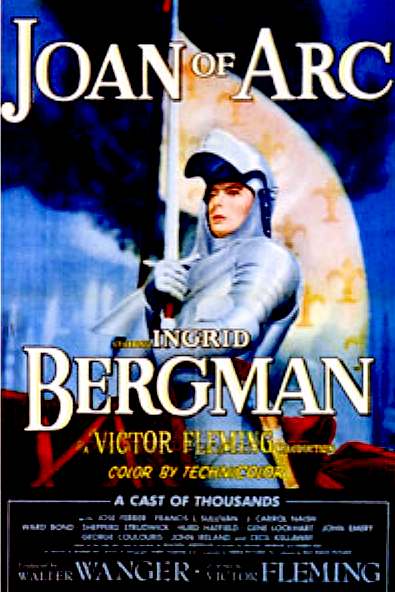
LEFT:
The Messenger - Movie poster. MIDDLE: Joan of Arc TV movie advertisement.
RIGHT: Joan of Arc 1948 movie with Ingrid Bergman. Moral of the story, we
always burn the one we love.
JOAN
OF ARC MOVIE - THE MESSENGER
The Messenger: The Story of Joan of Arc (French: Jeanne d'Arc) is a 1999 French historical drama
film directed by Luc Besson. The film stars Milla Jovovich, John Malkovich, Faye Dunaway and Dustin Hoffman. The screenplay was written by Besson and Andrew Birkin, and the original music score was composed by Éric Serra.
The Messenger portrays the story of St. Joan of Arc, the French war heroine and religious martyr of the 15th century. The story begins with young Joan witnessing the atrocities of the English against her family, and portrays her having visions that inspire her to lead the French in battle against the occupying English forces. Her success in routing the English allows Charles VII to take the throne. Eventually Joan is tried and executed for heresy.
Besson's previous film, The Fifth Element, which also starred Jovovich, was a critical and financial success, and had a positive influence on both of their career's. The Messenger was intended to follow up that success, and cement the status' of Besson and Jovovich in film. However, the film received mixed to negative reviews from critics, and also performed poorly at the box office, earning just under $67 million on an
$85
million budget.
Joan
of Arc - Youtube
LINKS
Wikipedia
The_Messenger_The_Story_of_Joan_of_Arc
rotten
tomatoes joan_of_arc
Wikipedia
Joan_of_Arc
http://en.wikipedia.org/wiki/The_Messenger:_The_Story_of_Joan_of_Arc
http://www.rottentomatoes.com/m/1088045-joan_of_arc/
http://en.wikipedia.org/wiki/Joan_of_Arc_%281948_film%29

Environmental
extremists steal the Astute
submarine, blow up an oil
rig as a warning and when NATO
sends in the big guns, the terrorists sink the USS
Jimmy Carter nuclear submarine and the USS
Nimitz aircraft carrier. Where brute force has failed, John Storm is
called in to save the day.
|






